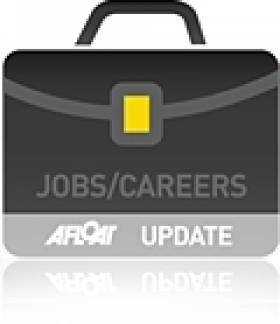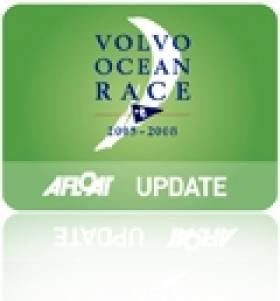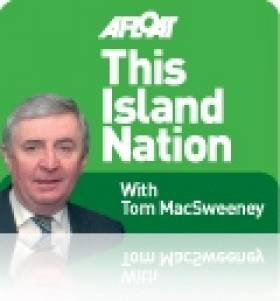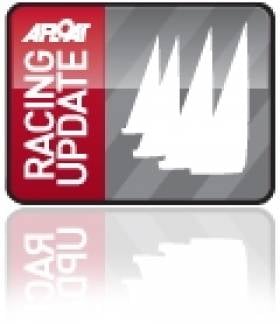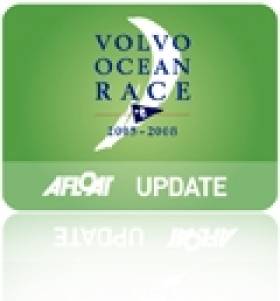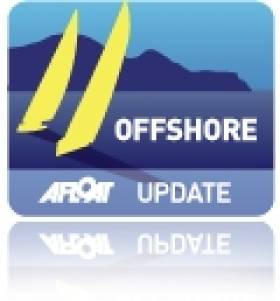Displaying items by tag: VOR
#MARINE JOBS – As the festivities of the Volvo Ocean Race gain further momentum following this morning's final offshore race leg to Galway Harbour, the Marine Institute and SmartOcean Ireland are also to be present during the prestigious event as they are to host 'Oceans of Opportunity'.
Oceans of Opportunity, is a marine careers and training event (held this Thursday 5th and Friday 6th July) which is part of the Ocean Wealth Showcase at the Volvo Ocean Race Global Village. More than 80 Irish-based marine jobs will be on offer at the event and over 140 international opportunities.
A wide variety of marine jobs will be on offer at the event with a number of organisations (across shipping, technology, research, energy, and cruise line hospitality) actively recruiting over the two days. Information on the current opportunities will also be available on www.marinejobs.ie which will be launched this Thursday.
Speaking ahead of the event Dr Peter Heffernan, CEO Marine Institute said "This event highlights the wide variety of job opportunities that are available right now in the marine sector. It will be a great opportunity for those looking for a position in this area to meet with recruiters at the event.
For those who are just thinking about a career in the marine sector, it will be a chance to get some insight into the wide variety of opportunities available, including in maritime education and training".
Among those recruiting at the event are DCU (MSc, PhD, PostDoc positions), IBM (technical and engineering), Marine Institute (graduate opportunities) and the Chamber of Shipping. Experienced HR specialists will be on hand to provide advice on preparing for a career in the marine sector.
The Marine Institute and the Irish Maritime Development Office (IMDO) will also be offering marine career advice, job opportunities, CV workshops and clinics to support and advise job seekers looking to work in the marine sector.
A series of short talks are also scheduled throughout this Thursday, giving 'a day in the life' insight into the variety of careers that are available in the marine sector. For information on the schedule visit www.marine.ie or www.marinejobs.ie
Companies who wish to promote job opportunities on www.marinejobs.ie should contact [email protected]
New Volvo Ocean Race 65 Design Announced for Next Race
#VOR – The Volvo Ocean Race will have eight boats next time round and in a major departure from the current race a new design has been revealed. The idea is to reduce the cost of mounting a competitive campaign and stem dwindling entry numbers. The new design was revealed as details of the Notice of Race and the race route for the 2014 VOR were discussed by Volvo Ocean Race CEO Knut Frostad at a presentation in Lorient, France this morning, the ninth host port of the race.
The first new boats 65 will launch in June 2013. One new boat will launch every seven weeks. The price of the VO 65 is €4.5m, about a million less than the current box rule boats which will be obsolete when the fleet hits Galway next week. Finance of the new yacht design and the production of the boat will be underwritten by the race sponsor Volvo.
The new boats will be built by th UK's Greene Marine.
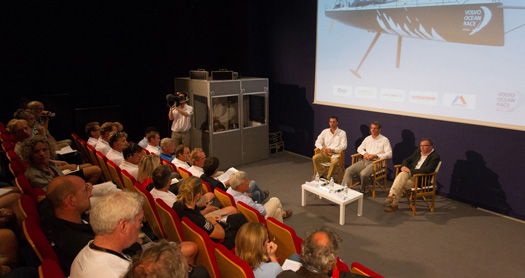
Knut Frostad reveals the new 65 footer this morning. Photo: Ian Roman/VOR
The one design will have eight crew plus a media man. The race is keen to attract female teams which will have 10 crew.
Renderings of the new Volvo Ocean Race boat design that will be used in the next two editions of the Volvo Ocean Race. The new boat design from Farr Yacht Design was unveiled today.
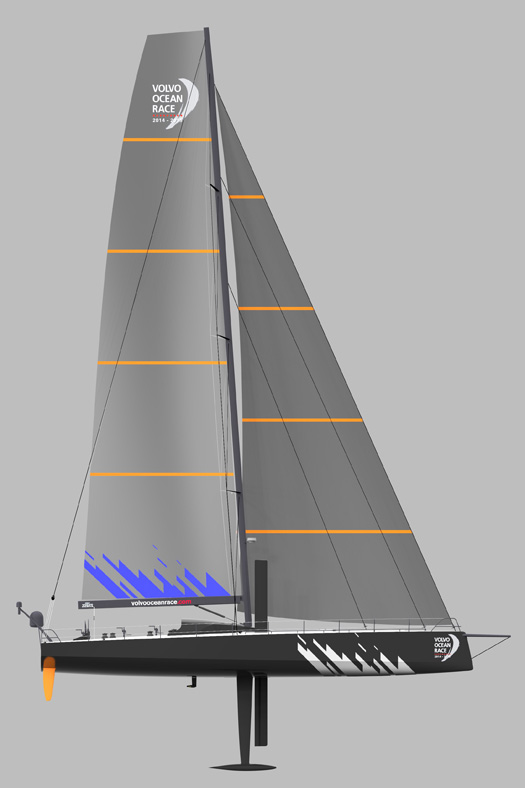
The Pace Picks Up in Galway
#islandnation – THIS WEEK : Smelly humans, the pace picks up in Galway, pirates in Baltimore, the response of fishermen to the condescending RNLI and a Cork beauty are amongst my topics this week, read on .....
GALWAY PACE PICKS UP
There is an increasing buzz of excitement in Galway where the pace has picked up notably this week with work well underway on constructing the Volvo Ocean Race Village and increasing hope that Damian Foxall could be representing Ireland on the overall Volvo winners' podium in the City of the Tribes. It is still disappointing that the general media is not focussing attention on Ireland's two top international sailors in the race - Damian from Kerry and a member of Kinsale Yacht Club who is aboard the French entry Groupama and Justin Slattery from Cork who is with Abu Dhabi Ocean Racing.
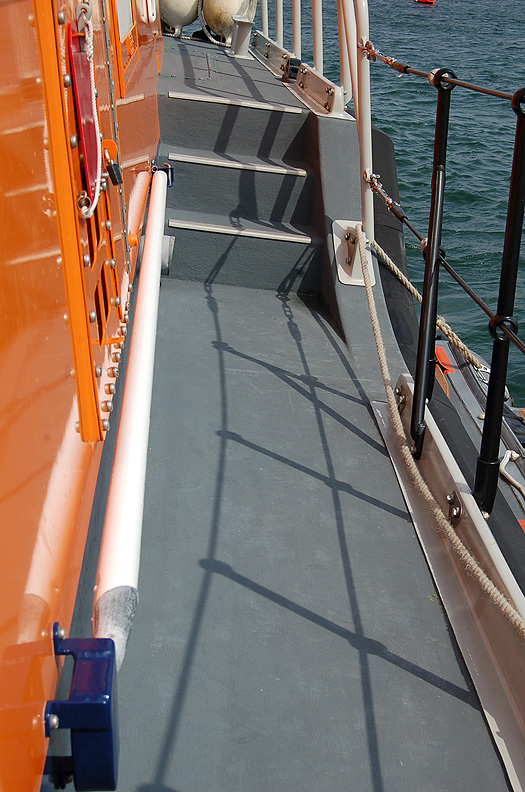
The boat hook on Achill lifeboat
FISHERMEN TELL OFF THE RNLI
Dick Robinson, former lifeboat crewman from Valentia Island and author of several books about the lifeboat service, has written to me about my visit to the Achill Island lifeboat when I said I had learned that the two boat hooks on modern lifeboats are the only items remains as a tradition from the past."
Dick confirms that this is a reminder of the rowing lifeboat days:
"The RNLI at that time issued a rather condescending circular that white oars were to be used to starboard and blue to port, as 'the orthodox terms, starboard and port are rarely used in lifeboat work since many lifeboatmen are unaccustomed to nautical phraseology.' The Penlee crew reversed the placings as a protest against the tone of that circular.
"The orders from the Coxswain would be 'Forward the white, Back the blue' or reverse as appropriate. The boats would have no steerage way working in close, so the rudder would not be effective and so oars had to be worked all the time. The oars were the subject of considerable research as oars breaking during beaching or launching operations could be fatal. In 1866 trials were carried out involving 38 different types of wood. The best oars were found to be made from young trees in Norwegian and Baltic Wood, followed by oars made from planks of the same woods. Oregon Pine was also good. A balance had to be struck between oars which would break under ordinary conditions and ones which would not break if the lifeboat struck bottom in shallow waters and thereby might capsize her. Later oars were balanced with lead inside."
Thanks Dick for this information on a fascinating topic.
PIRATES IN BALTIMORE
The sacking of Baltimore village, a very popular sailing destination in West Cork, is the topic of a 'PIRATE SEMINAR' – an unusual addition to the list of maritime events this summer. It will be held next weekend, starting on Friday night, June 29 and running until Sunday, July 1, including events for all the family.
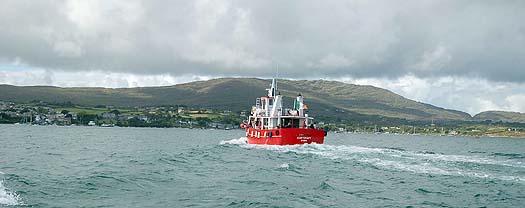
The Schull – Baltimore – Cape Clear ferry departs Baltimore
Des Ekin, Assistant Editor with the Sunday World and author of the book – 'The Stolen Village' will discuss the 'Sack of Baltimore' in 1631 when inhabitants were taken off to slavery in Algiers. Connie Kelleher, Underwater Archaeologist with the Dept. of the Arts, Heritage and the Gaeltacht's Underwater Unit will discuss piracy in southwest Ireland in the seventeenth century.
New to Baltimore is a permanent 'piratical exhibition' at Dún na Séad castle, with details of the raid on the village and copies of rare graphics from the seventeenth century depicting the story of the Baltimore captives who were taken into a life of slavery. Details are also shown of the activities of the O'Driscoll clan and their notorious involvement with the men of Waterford during the middle ages. A depiction of Thomas Crooke, the English 'pirate/planter' is also featured. An accompanying feature of the exhibition is a new book by Bernie McCarthy called 'Pirates of Baltimore,' containing images of lifestyles and events associated with the piratical history of the village. Did you ever imagine the respectable Baltimore of today to have such a history!
The exhibition is open daily 11am – 6 pm.
THE BEAUTY OF TRADITION
There is a great beauty in traditional boats and the one pictured here, the Peel Castle, was for me the star of this year's Crosshaven Traditional Boats Gathering. She is owned by Graham Bailey and deservedly won the top prize at the event. A fishing lugger she was built back in 1929 at Porthleven in Cornwall, carvel, pitch pine planking on oak frames and her original engine power was 2 x 25 hp Alphas - currently 120hp Ford D series.
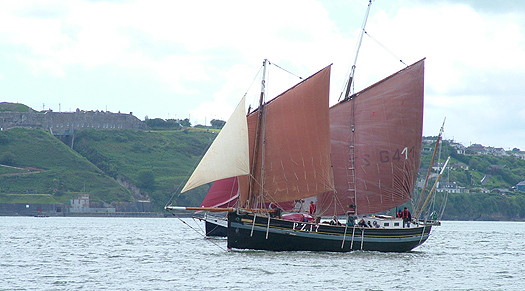
The Peel Caslte racing off Crosshaven
She was registered PZ17 at Penzance, later BM17 Brixham, Devon. She also fished out of Fleetwood from1968 and finished fishing in 1977 when she was de-registered. Re-registered in Skibbereen in 2008, she has sailed extensively in European waters. Restoration work was done at Hegarty's Old Court Boatyard and is impressive. Graham, a shipwright, also restored her internally. Visitors aboard were very impressed.
GASSY HUMANS!
Human-produced gas emissions are a significant cause of ocean warming!
Average ocean temperatures have been rising by 0.045 degrees per decade for the past half-century and natural fluctuations alone "do not explain warming in the upper layers of the planet's oceans," according to the Lawrence Livermore National USA National Laboratory. "Human greenhouse gas emissions are an added ingredient and strengthen the conclusion that most of the global ocean warming over the past 50 years is attributable to human activities," according to Livermore climate scientist Peter Gleckler.
The Californian Laboratory which made these findings in a desktop computer modelling study of the Atlantic and Pacific Oceans also researches protection against weapons of mass destruction!
To Email your comments to THIS ISLAND NATION: [email protected]
Follow Tom MacSweeney on Twitter @TomMacSweeney and on Facebook
#IRISH SAILING UPDATE – Ireland's out of the Commodore's Cup, Team Toy Yot are sailors of the month, watch out today for big tides, there's a full moon, diamond sailing on Loch Fyne, we have the pics, a Bangor couple made the Thames, Olympic torch visits the Howth 17s, an offshore race ends with lifeboat assistance in Dun Laoghaire, ISORA Race four results here, Ballycotton rescues a vessel taking on water and a Fireballer heads offshore, preparations continue for VOR in Galway, are you bringing your boat? Watch out for whales! Check out this near miss. Cork week's own 1720s are going to be centre stage in July. And isn't it great President Higgins is showing a maritime interest?
Irish Sailing Round-Up: Wilson Trophy, 470, Star, SB20, 420, VOR, Rd Irl, ISORA & Comm Cup
#SAILING – Schull Youth Team from West Cork won the Under 21 Trophy at the Wilson Trophy in West Kirby in the UK yesterday and it represented a sweet revenge for the teenage three boat team.
Dublin's Ger Owens and Scott Flanigan final chance for Olympic selection at the 470 World Championships in Barcelona got off to a flying start yesterday with the double Olympian Owens finishing fifth in the opening race. It is an early boost for one of 7 remaining places left in the Summer Olympics. Ross Hamilton is also trying to qualify in the Finn class, he lies
It may have been 'gutting' not to come away with a medal at the Star world championships where Peter O'Leary and and David Burrows finished fourth overall but it was nevertheless a fantastic performance for the London qualified pairing who were third overall for most of last week.
Ben Duncan continues his domination of the SB3 class with a win in the 2012 Eastern Championships yesterday at the National Yacht Club who celebrated its yacht club of the year award last Wednesday.
There was success for Class III champion Supernova plus results from all 19 DBSC classes on Saturday in Dublin Bay.
Cork Harbour's Patrick Crosbie and Grattan Roberts were 420 dinghy winners at Galway Bay Sailing Club.
Offshore American Kenny Read and Team Puma is in back in the USA, a Volvo Ocean Race Win on the home waters of Miami all the more satisfying. The race will finish in Galway at the end of next month.
Billed as one of Europe's major yacht racing events, the 2012 Round Ireland Race starts on June 24th and an international fleet has been announced with UK entries at an all time high for Ireland's top offshore fixture.
Offshore sailing is on a high thanks largely to the pioneeing work of Peter Ryan with the Irish Sea fleet and why shouldn't we be our exploiting our offshore assets, sure don't we own 220 million acres? The third ISORA Race this weekend will feature virtual marks on the way to the Howth finish.
The title holder's absence may be Hong Kong's opportunity at the 2012 Commodore's Cup. Where is Team Ireland as Hong Kong builds up for the cup in just two month's time?
And in two week's time Howth Yacht Club report they have reached the magic number of 100 for the ICRA Cruiser Nationals at the North Dublin venue.
Chinese Irish Entry Announces Leg One Retirement
Mike Sanderson, CEO/Skipper of Team Sanya, spent time today elaborating on the events at sea on the morning of Sunday 6th November, and the team's intention to get back in the race as quickly as possible,
"We were moving along nicely and very happy with our progress, managing the big breeze and waves very nicely, we were not pushing 100% and had decided to throttle back a knot or so given the conditions; we felt we were in a comfortable zone. I had just had a chat with the guys when we suddenly felt a very odd lurch, like dragging the keel through soft mud. The guys on deck saw a lot of water coming into the bow and we could also hear the noise of water coming into the bow. The watertight doors were already shut thankfully.
We got everyone up and into lifejackets. For sure if the watertight doors had not been shut, we would have been sunk. We avoided the bear away for a time, which was a pretty tense time, we got the pumps going but they were not really making much difference. After a time our situation stabilized, we were nursing the boat upwind at 4-5 knots and then we bore away, got the jib down and suspended sailing as we headed into port.
Initially we had no idea of the extent of the damage, whether it was a small puncture wound or something larger. We could then see some carbon shards coming off the bow, which we realized were the uni directional fibres peeling back and we then realized the severity of the situation. Once we were at the dock in Motril we could see we had a deal breaker on our hands in terms of not being able to carry on racing from here to Cape Town.
With regard to the injury of our bowman, Andy Meiklejohn, he had an unfortunate bad accident in a completely unrelated incident. We were going through a jib change with Andy on the bow in extremely rough conditions and we had reduced speed from 13 down to around 6/7 knots and were nursing her through the waves. We were then hit by a series of massive waves (most likely the same ones that brought down the Abu Dhabi rig). Andy came down badly on his ankle/foot and sustained an injury. We contacted Race Office but were not sure of the breakage at that time. One hour later we were headed for shore due to the bow damage and so thankfully we were able to get him to the local hospital to be assessed where they confirmed he had indeed broken his foot. Andy is now in the process of receiving medical advise and will be treated asap.
Andy is an extremely pivotal team member and will be sorely missed while he is off. We will asses his recovery time and look at our Plan B for a replacement should we need one.
We are now 100% focused on getting the boat to Cape Town as soon as possible that would leave us 8-9 days in Cape Town before the start. Our worst-case scenario is that we ship to Cape Town but then we don't have time to fix it in time so we are late starting from Cape Town and then miss the ship from our stop point during leg 2.
This is no small task, we have a chop out a 6m x 3m x 1m section of the boat and replace it – normally a 2-3 week job shoehorned into 7 days. But this is the Volvo Ocean Race and we will do what we have to do to make it happen.
One fact that gives me some peace is that damage was not caused by anything we did wrong. For sure I have to believe that we hit something that caused the initial puncture wound that then peeled backwards. We were performing well and in good shape, we have not incurred one other bit of damage in those 24 hours so that is good news.
We need to take the time to do some serious thinking and planning, assessing the logistical options and making the right choices that get us back in the race as soon as possible. We need to repair the hull perfectly; a rush job is not an option.
From a personal point of view I have never before retired from a Whitbread or Volvo leg and so it's a pretty sad moment. We were very comfortable with how we were sailing and so it's extremely disappointing for the guys. Looking back on it we wouldn't do anything differently than we did so it's a good feeling that we handled the situation well.
For us as a team, we can still absolutely achieve everything we have set out to do – win some podium positions and take a few scalps from the other teams – and we fully intend to do that still. It is tragic to be out of this leg for sure but perhaps it would have been more tragic for one of the teams focusing on the overall event win.
Accidents do happen and now its all about the tenacity and focus to get it right, we don't give up, we're all dying to get back into the race, it was gut wrenching getting off the boat in Motril and seeing a big part of the boat missing.
Nothing about this team is reckless, we're not quitters or unprofessional in any way, we have a great bunch of guys here and I have absolute confidence that we will get back on the race track as soon as we possibly can. For now it's a full frenzy of activity to get our Sanya Lan race boat on a ship this Friday and turn a boat building job of 2-3 weeks into 7 days!"
Team Sanya will confirm shipping route and dates of departure and arrival into Cape Town as soon as that information is confirmed to them.



























